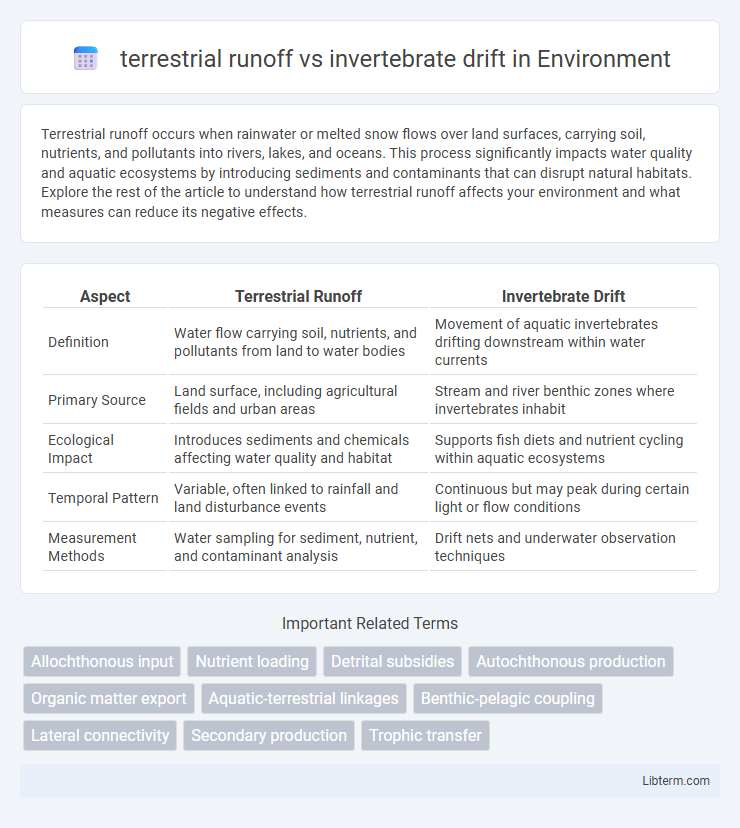Terrestrial runoff occurs when rainwater or melted snow flows over land surfaces, carrying soil, nutrients, and pollutants into rivers, lakes, and oceans. This process significantly impacts water quality and aquatic ecosystems by introducing sediments and contaminants that can disrupt natural habitats. Explore the rest of the article to understand how terrestrial runoff affects your environment and what measures can reduce its negative effects.
Table of Comparison
| Aspect | Terrestrial Runoff | Invertebrate Drift |
|---|---|---|
| Definition | Water flow carrying soil, nutrients, and pollutants from land to water bodies | Movement of aquatic invertebrates drifting downstream within water currents |
| Primary Source | Land surface, including agricultural fields and urban areas | Stream and river benthic zones where invertebrates inhabit |
| Ecological Impact | Introduces sediments and chemicals affecting water quality and habitat | Supports fish diets and nutrient cycling within aquatic ecosystems |
| Temporal Pattern | Variable, often linked to rainfall and land disturbance events | Continuous but may peak during certain light or flow conditions |
| Measurement Methods | Water sampling for sediment, nutrient, and contaminant analysis | Drift nets and underwater observation techniques |
Introduction to Terrestrial Runoff and Invertebrate Drift
Terrestrial runoff transports nutrients, sediments, and organic matter from land to aquatic ecosystems, significantly impacting water quality and habitat conditions. Invertebrate drift refers to the downstream movement of aquatic invertebrates within stream habitats, influenced by environmental factors such as flow velocity and substrate composition. Understanding the interactions between terrestrial runoff and invertebrate drift is essential for evaluating ecosystem health and nutrient cycling in freshwater environments.
Defining Terrestrial Runoff
Terrestrial runoff refers to water from rainfall or melting snow that flows over land surfaces, carrying soil, nutrients, and organic matter into aquatic ecosystems. This process significantly impacts stream and river habitats by altering water quality and sediment composition. Unlike invertebrate drift, which involves the downstream movement of aquatic organisms, terrestrial runoff primarily influences ecosystems through physical and chemical inputs.
Understanding Invertebrate Drift
Invertebrate drift refers to the downstream movement of aquatic invertebrates, a crucial process for dispersal and population dynamics in freshwater ecosystems. Terrestrial runoff influences invertebrate drift by altering water quality, sediment load, and nutrient levels, which affect habitat conditions and invertebrate behavior. Understanding the interplay between terrestrial runoff and invertebrate drift helps in predicting ecological responses to environmental changes and managing freshwater biodiversity.
Key Differences Between Runoff and Drift
Terrestrial runoff primarily consists of water, sediments, and nutrients flowing over land into aquatic ecosystems, often influenced by rainfall and landscape features, while invertebrate drift involves the passive downstream movement of aquatic organisms like insects and crustaceans within a stream or river. Runoff transports abiotic materials such as sediments, pollutants, and organic matter, significantly affecting water quality and ecosystem health. In contrast, invertebrate drift plays a crucial role in stream ecology by facilitating dispersal, predator-prey dynamics, and nutrient cycling within freshwater habitats.
Sources and Drivers of Terrestrial Runoff
Terrestrial runoff primarily originates from precipitation, snowmelt, and irrigation, transporting nutrients, sediments, and organic matter from land surfaces into aquatic systems. Key drivers include land use changes such as urbanization, deforestation, and agriculture, which increase surface runoff and pollutant load. In contrast, invertebrate drift results from behavioral and environmental factors affecting aquatic invertebrates, independent of terrestrial runoff inputs.
Ecological Impact of Invertebrate Drift
Invertebrate drift plays a crucial role in freshwater ecosystems by distributing aquatic organisms downstream, supporting fish populations and maintaining biodiversity. Unlike terrestrial runoff, which often introduces pollutants and sediments that degrade water quality, invertebrate drift enhances nutrient cycling and energy flow within aquatic food webs. The ecological impact of invertebrate drift includes sustaining predator-prey dynamics and promoting ecosystem resilience against environmental stressors.
Role in Aquatic Food Webs
Terrestrial runoff delivers essential nutrients and organic matter that fuel primary production in aquatic ecosystems, thereby supporting diverse food webs. Invertebrate drift acts as a mechanism for distributing aquatic insects and larvae, serving as a crucial food source for fish and other predators. Together, these processes facilitate energy transfer and maintain the balance and productivity of aquatic food webs.
Temporal and Spatial Patterns
Terrestrial runoff exhibits pronounced temporal patterns, often peaking during storm events and seasonal rainfall, leading to increased nutrient and sediment input in freshwater ecosystems. Invertebrate drift shows diel and seasonal fluctuations, with higher drift rates typically occurring during nighttime and certain life stages, reflecting behavioral adaptations and environmental cues. Spatially, terrestrial runoff impacts are concentrated near riparian zones and watershed outlets, whereas invertebrate drift disperses downstream, influenced by stream flow, habitat complexity, and predator presence.
Measurement and Monitoring Methods
Terrestrial runoff measurement techniques commonly use automated samplers and turbidity sensors to quantify sediment and nutrient loads entering aquatic systems, while invertebrate drift monitoring relies on drift nets and benthic samplers to capture and quantify macroinvertebrate populations in streamflow. Continuous data logging combined with periodic manual sampling enhances accuracy in runoff studies, whereas invertebrate drift assessments often involve time-specific collection to observe diel or episodic patterns. Both approaches utilize GIS and remote sensing data to contextualize findings within watershed-scale hydrological processes and biological responses.
Management and Conservation Implications
Effective management of aquatic ecosystems requires understanding the contrasting influences of terrestrial runoff and invertebrate drift on nutrient cycling and habitat quality. Controlling terrestrial runoff through best management practices reduces sedimentation and pollution, thereby preserving water clarity essential for invertebrate communities crucial to food webs. Conservation strategies should integrate monitoring of invertebrate drift patterns to maintain biodiversity and ecosystem resilience in freshwater habitats.
terrestrial runoff Infographic

 libterm.com
libterm.com